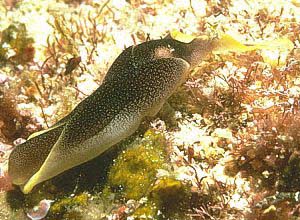
Chelidonura amoena
Bergh, 1905
Order: CEPHALASPIDEA
Superfamily: PHILINOIDEA
Family: Aglajidae
DISTRIBUTION
Tropical western Pacific.
PHOTO
Steep Point, Shark Bay, Western Australia. 5cm long alive. PHOTO: Clay Bryce.
This is a relatively dark form of Chelidonura amoena. The lightest colour form has a background colour of white with the grey-black reticulate pattern restricted to the dorsal surface of the headshield and posterior shield, and to the small sections of the parapodia which fold over the dorsal surface of the body.
Reference:
• Bergh, R. (1905). Die Opsithobranchiata der Siboga-Expidition. Siboga Expiditie, 50: Leiden, E.J. Brill. 248 pp.
Rudman, W.B., 1998 (October 26) Chelidonura amoena Bergh, 1905. [In] Sea Slug Forum. Australian Museum, Sydney. Available from http://www.seaslugforum.net/find/chelamoe
Related messages
Color variation in Chelidonura amoena from Lembeh
July 27, 2007
From: Mike Krampf
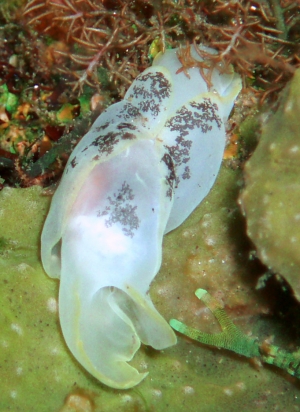
I was reading the past posting on Chelidonura amoena and there was quite a bit regarding color variations. I thought you might find this picture interesting. My guess is Chelidonura amoena. Your thoughts?
Locality: Dive Site - Jahir 2 in Lembeh Strait, 25 ft, North Sulawesi, Indonesia, Molucca Sea, 02 July 2007, Sandy bottom with scattered reef patches. Length: 4 cm. Photographer: Mike Krampf.
Cheers,
Mike
mtkrampf@yahoo.com
Krampf, M., 2007 (Jul 27) Color variation in Chelidonura amoena from Lembeh. [Message in] Sea Slug Forum. Australian Museum, Sydney. Available from http://www.seaslugforum.net/find/20165Dear Mike,
I entitled one earlier message [#18490] "Are Chelidonura electra and Chelidonura amoena one species? " and your photo certainly adds weight to the 'yes' answer. As I said previously, it would be good to find a mixed population showing all colour variants beween pure white and totally grey. I guess I am a little bit biased because if they are the same, C. electra Rudman, 1970 is the one that would go.
Best wishes,
Bill Rudman
Re: Chelidonura amoena piggyback
July 17, 2007
From: Kristin Anderson
Concerning message #20076:
You're right, I'm bad! Just being lazy in my usage of terms.
Kristin
kristin@oceansbyanderson.com
Anderson, K.J., 2007 (Jul 17) Re: Chelidonura amoena piggyback. [Message in] Sea Slug Forum. Australian Museum, Sydney. Available from http://www.seaslugforum.net/find/20201Dear Kristin,
I hope you don't feel too bad. Nudibranch = seaslug is an incorrect usage found in many parts of the world - even in the titles of popular books. Every now and then my crusading zeal takes over and I feel the need to make the point again that Opisthobranch = seaslug. Just your bad luck it was your message!
Best wishes,
Bill Rudman
Chelidonura amoena piggyback
July 12, 2007
From: Kristin Anderson

Dear Bill
Although we see Chelidonura amoena nudibranchs quite often on a wide variety of our sites - both singly and in groups, I have not seen them "riding" each other before. Just thought it was interesting.
Locality: Ningaloo Reef, 12m, Western Australia, Indian Ocean, 16 June 2007, limestone/coral reef. Length: 3 cm. Photographer: Kristin Anderson.
Kristin Anderson
kristin@oceansbyanderson.com
Anderson, K.J., 2007 (Jul 12) Chelidonura amoena piggyback. [Message in] Sea Slug Forum. Australian Museum, Sydney. Available from http://www.seaslugforum.net/find/20076Dear Kristin,
I can't say I have seen Chelidonura doing this either, but it does remind me of a photo I have on the Fact Sheet for Aplysia cf parvula of a small animal sitting on a larger one for some time with its penis inserted in the female opening of the larger animal. As you know all opisthobranchs are hermaphrodite with functional male and female reproductive systems. In quite a few cases the male system matures before the female system so younger animals can be fuctional males before their 'female half' matures. In the case of the Aplysia I am pretty sure this 'mating' could have been successful. So seeing your photo I wondered if this was a similar case. It's possible, as the female genital opening of the larger animal is just below the small animal's head, but I can't see any sign that its penis is extended.
On a more general point you talk of Chelidonura as a 'nudibranch'. I know nudibranch is sometimes used to mean seaslug but it has a precise scientific meaning and applies only to one group of sea slugs, namely the shell-less carnivorous group which includes the dorids, aeolids, arminids, tritoniids and their relatives. A general name for seaslugs is opisthobranch - and that includes the nudibranchs, pleurobranchs, cephalaspidean bubble shells, the aplysiid sea hares, and sacoglossans and other minor groups.
Best wishes,
Bill Rudman
Re: Chelidonura amoena from the Philippines
May 15, 2007
From: Jose Victor Santos
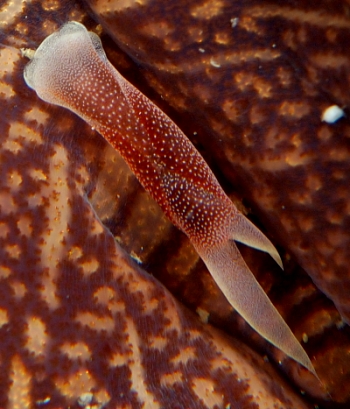
Concerning message #4575:
Hi Bill,
I think I have encountered the same species - Chelidonura amoena - but need your confirmation on this. It was in about 10 m of water ... in Anilao, Batangas, Philippines at the Arthurs rock divesite. Hope you can help.
Locality: Anilao, Batangas, 10m, Philippines, 28 April 2007. Length: 3-4mm. Photographer: Jose Victor Santos.
I was wondering if this slug actually grows bigger? This was about 3-4 mm long and was moving in quite fast pace crawl on the mantle of a big clam.
Thanks in advance.
Jose Victor Santos
msdt_jovic@yahoo.com
Santos, J.V.R., 2007 (May 15) Re: Chelidonura amoena from the Philippines. [Message in] Sea Slug Forum. Australian Museum, Sydney. Available from http://www.seaslugforum.net/find/19878
Dear Jovic,
Yes your animal is Chelidonura amoena. Congratulations on seeing one so small. I see I have no mention of size on the Fact Sheet but if you have a look through earlier messages about this species you will see it grows to about 6 cm in length, so your animal was very juvenile.
Best wishes,
Bill Rudman
Re: Are Chelidonura electra and C. amoena the same?
November 24, 2006
From: Roberto Sozzani
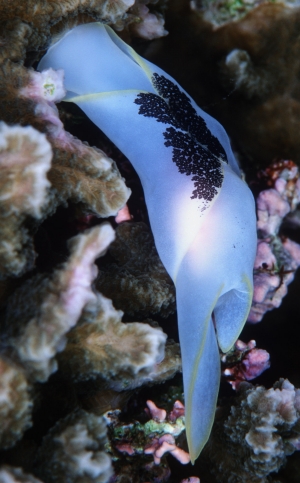
Concerning message #18490:
Dear Bill,
I've a photo of a very similar specimen. It was with two other animals: one with a lot of black spot and another one which looks heavily damaged.
Near them, many small flatworms (see my message #14978 ).
The photos were shot at Rinja island, which is not far from Sangeang island, in the same Komodo area.
Locality: Rinja Island, 12 metres, Indonesia, Pacific Ocean, June 2003, Coral reef. Length: 4 cm. Photographer: Roberto Sozzani.
Best wishes
Roberto Sozzani
www.robertosozzani.it
roberto.sozzani@fastwebnet.it
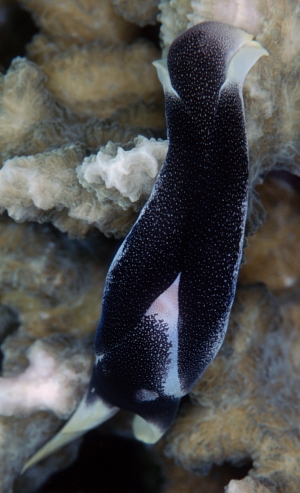

Thanks Roberto,
It certainly seems like we need to look more carefully at these two 'species'. Their general body shape and habit of crawling over large coral colonies in search of prey are very similar. Perhaps DNA may be the answer.
Best wishes,
Bill Rudman
Are Chelidonura electra and Chelidonura amoena one species?
November 22, 2006
From: Linda Ianniello
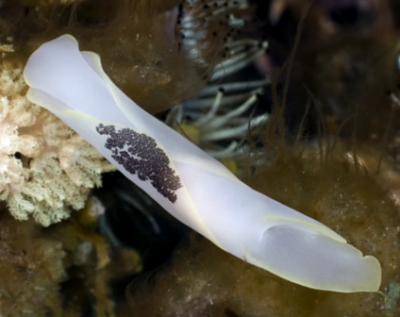
Concerning message #18378:
Which one do you think it is - Chelidonura electra or C. amoena, or a hybrid? It looks like C. electra, but I can't find any reference to one with spots?
Locality: Sambousa Island, Sangean, Tikno Reef, 60 feet, Indonesia, 5 September 2006, Coral reef. Photographer: Linda Ianniello.
Regards,
Linda I.
lindai1@bellsouth.net
Ianniello, L.M., 2006 (Nov 22) Are Chelidonura electra and Chelidonura amoena one species?. [Message in] Sea Slug Forum. Australian Museum, Sydney. Available from http://www.seaslugforum.net/find/18490Dear Linda,
I must say I have never seen one with a colour pattern quite like this before. Richard Willan [message #9637] describes a similarly coloured animal as a hybrid between C. electra and C. amoena, but I am not happy with the concept of hybrids. It seems to me that they are either two species or one. There is one photo on the Forum from Christmas Island [#6622] which is quite like your animal, but because it lacks a yellow border I had no qualms in considering to be C. amoena. Looking through the photos of C. amoena, those that have some yellow colouring, usually have it just around the edge of the 'tails'.
Both species have a very similar shape with a large left 'tail' and a much smaller right 'tail'. I am still undecided on whether they are one or two species. One thing that puzzles me is that if they are colour variants of one species why don't we find mixed populations together? At times we find many hundreds of small C. electra and C. inornata on rock platforms around Sydney. I have never seen a specimen with even a small dark patch. Similarly, there are a number of reports of large numbers of C. amoena on the Forum, but no mention of pure white ones. As I said when discussing Richard Willan's message, all I can ask is for everyone to add this to their list of things to look out for.
Best wishes,
Bill Rudman
Chelidonura amoena from Malaysia
August 12, 2006
From: Asther M. Lau
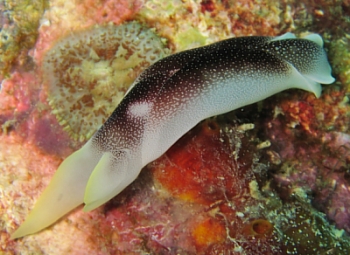
Hello again,
Here's a Chelidonura amoena. It was crawling and lifted its head at one moment.
Locality: Tenggol Island, Approx. 18m, Terengganu, Malaysia, South China Sea, 24 July 2004, Rich coral reef. Length: About 4cm. Photographer: Asther M. Lau.
Regards,
Asther
asther@astherlau.com
Lau, A, 2006 (Aug 12) Chelidonura amoena from Malaysia. [Message in] Sea Slug Forum. Australian Museum, Sydney. Available from http://www.seaslugforum.net/find/17368
Thanks Asther,
Best wishes,
Bill Rudman
Chelidonura amoena from Komodo, Indonesia?
July 26, 2006
From: Robert Whitton
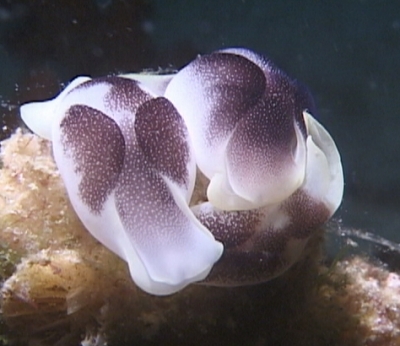
Aloha Bill,
Thanks for such a great web resource. I have attached a still image from a video clip shot near Gili Mota in Komodo this April (2006).
Locality: Gili Mota, Komodo National Park, 50 feet, Indonesia, 18 April 2006, Coral rubble. Length: 1.5 inches. Photographer: Robert Whitton
The group of Chelidonura? continued to mate undisturbed while I filmed.
Any ID assistance would be appreciated.
Thanks again,
Rob
whittonr@gmail.com
Whitton, R.K., 2006 (Jul 26) Chelidonura amoena from Komodo, Indonesia?. [Message in] Sea Slug Forum. Australian Museum, Sydney. Available from http://www.seaslugforum.net/find/17204Dear Rob,
This is Chelidonura amoena. To be pedantic, I can't actually see any sign of actual mating in this frame. In these animals the penis is on the right side of the head, and the female genital opening is on the right side just behind the posterior end of the parapodia. Usually, but not always, they mate 'head to tail' .
Best wishes,
Bill Rudman
Chelidonura amoena in Taiwan
July 25, 2006
From: Alex Tattersall
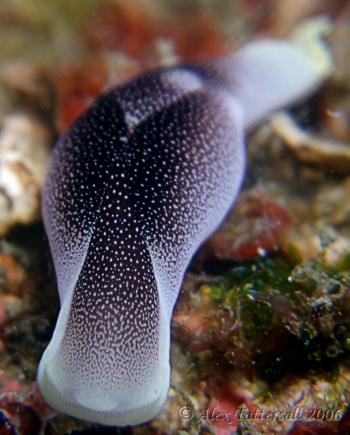
Hi there,
Not sure if you want these but yesterday on the NE Coast of Taiwan I saw several of these slugs [Chelidonura amoena ] ... one was in the process of laying eggs as you can see in the second picture.
Locality: Long Dong Wan, 7-10metres, Taiwan NE Coast, Pacific, 23 July 2006. Length: 30mm. Photographer: Alex Tattersall.
I have more Taiwan slug shots if you are interested.
Best wishes
Alex
alex_tattersall@hotmail.com
Tattersall, A.M., 2006 (Jul 25) Chelidonura amoena in Taiwan. [Message in] Sea Slug Forum. Australian Museum, Sydney. Available from http://www.seaslugforum.net/find/17211
Dear Alex,
Thanks for these pictures. This group of slugs [Aglajidae] seem to shape their bubble-shaped egg mass by first wrapping the string of eggs around the head, as the animal has done in your photo.
I would be interested in seeing other photos you have from Taiwan, although I can't guarantee they will be posted as quickly as this message.
Best wishes,
Bill Rudman
Pre-mating Ritual - Chelidonura amoena
June 7, 2006
From: Mike Krampf
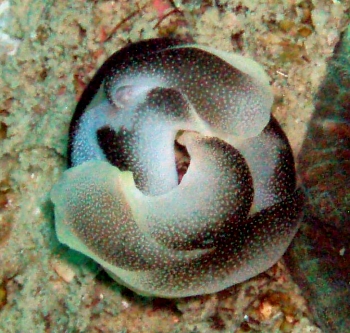
I thought I'd share this pic of Chelidonura amoena with you. It's the first time I've ever seen two sea slugs in a ball like this and a ID book I have describe this as a "pre-mating ritual". I thought it was very unique so I thought I'd share it with you.
Locality: Hatano Point, 30 feet, Miri, Sarawak, Malaysia, South China Sea, 27 May 2006, Patch Reef. Length: 3-4 cm. Photographer: Mike Krampf.
PS. I just found your site and think it's awesome!
Cheers,
Mike
mtkrampf@yahoo.com
Krampf, M., 2006 (Jun 7) Pre-mating Ritual - Chelidonura amoena. [Message in] Sea Slug Forum. Australian Museum, Sydney. Available from http://www.seaslugforum.net/find/16792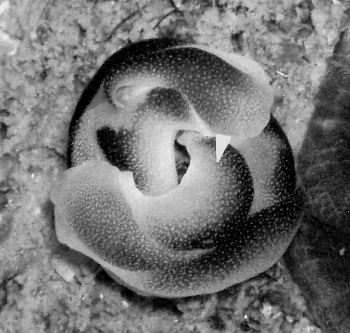
Dear Mike,
Have a look at the message reporting on a breeding aggregation of C. punctata [#16512]. I am pretty sure in your photo that the two Chelidonura are mating. In the copy of your photo alongside I have added a white triangle to represent the penis of the upper animal, which sits on the right side of the head. The female genital opening is at the back on the right side, under the parapodial flap - just about where the point of the white triangle is. These animals are hermaphrodites, with a fully functional male and female reproductive system, so in your photo, the upper animal is acting as male and the lower one as female. I suspect the lower animal is also trying to act as a male as well, and if he/she can get into the right position there is no functional reason why he/she can't act as both simultaneously.
True nudibranchs almost always act as both male and female simultaneously when they mate [see message #16116] but they are built a bit differently with all their reproductive organs together at one spot on the right side of the body.
Best wishes,
Bill Rudman
Chelidonura amoena from Derawan, Indonesia
December 13, 2005
From: Gennaro Ciavarella
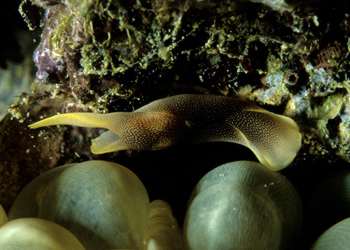
Hi Bill,
This is a sea slug from Derawan. I would be interested to know it's name.
Locality: Derawan, Indonesia. Depth: 15 metres. Length: 3 cm. 03 November 2005. Intertidal. Photographer: Gennaro Ciavarella
Gennaro Ciavarella
gciavarella@tin.it
Ciavarella, G., 2005 (Dec 13) Chelidonura amoena from Derawan, Indonesia. [Message in] Sea Slug Forum. Australian Museum, Sydney. Available from http://www.seaslugforum.net/find/15454Dear Gennaro,
This is Chelidonura amoena.
Best wishes,
Bill Rudman
Chelidonura amoena in Malaysia
September 11, 2003
From: Asther M. Lau
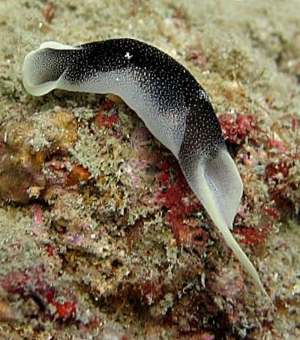
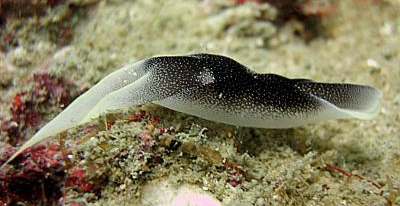
Dear Bill,
Please help identify this. My first encounter wth this species was in 2000, Chebeh Is. Tioman, East Coast Malaysia.
It was like a boom! In my 45 mins of dive, I found this species all along the way from depth 10 meter to about 21 meter. Even on one hard brain-coral, you can see near 30 of them covering the whole coral! What phenomenon is this?
Details of this pic:
Site: Terumbu Tiga [Perhentian Islands, Malaysia].
Date: July 11th, 2003
Depth: 14 meter
Size: Between 4cm to 6cm when stretched
Bottom contour: Sandy bottom
Thanx!
Asther M. Lau
diveworldwide@yahoo.com
Lau, A.M., 2003 (Sep 11) Chelidonura amoena in Malaysia. [Message in] Sea Slug Forum. Australian Museum, Sydney. Available from http://www.seaslugforum.net/find/10916
Dear Asther,
This is Chelidonura amoena.
This species seems to undergo these great population explosions at times. [See Todd Garthwaite's messages]. If you have any photos showing them covering a coral that would be interesting. Some popular book used to say that species of Chelidonura fed on coral mucus, because they were often found on large corals, though not in such numbers as you describe. I suspect they cluster on corals because they are hunting the small flatworms which often infest coral colonies. Perhaps if you have photos of large numbers of Chelidonura on corals, you could check for signs of flatworms.
Best wishes
Bill Rudman
Chelidonura amoena at Pulau Redang
September 11, 2003
From: Kheong Sann Chan
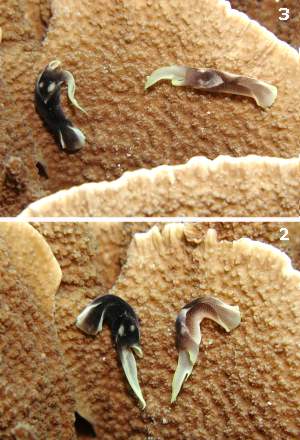
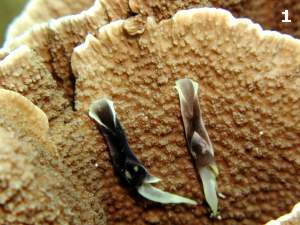
Hi Bill,
Could you ID these slugs for me? They were spotted by my buddy, they were climbing in unison up the side of the coral, then simultaneously turned away together almost as if it were choreographed. Then they later drifted off on their own paths. Do you suppose that it was pure chance that they happened to crawl in that manner, or do they do that for some reason?
Location: Redang Island, [East Coast of Peninsular Malaysia]
Date: 7 Sep 2003
Depth: approx 10m
Length: 5cm
The bottom was covered with lots of different types of corals, difficult to find a patch of sand to settle and take a photo.
Kheong.
kschan@mail.dsi.a-star.edu.sg
Chan, K.S., 2003 (Sep 11) Chelidonura amoena at Pulau Redang. [Message in] Sea Slug Forum. Australian Museum, Sydney. Available from http://www.seaslugforum.net/find/10931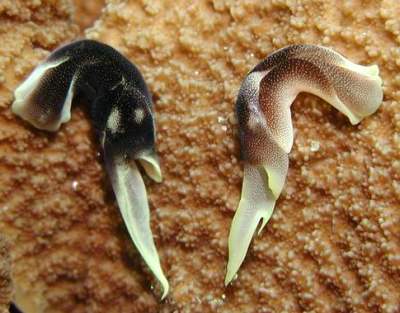
Dear Kheong,
Youe message arrived fortuitously just at I was posting Asther's message about the same species. It is Chelidonura amoena. As I said in her message, species of Chelidonura are often found crawling over massive coral colonies and it was often stated in popular books that they ate the coral mucus. I suspect they are in fact tracking down small flatworms which often occur on corals in large numbers. The choreographed turn you describe is probably just because they are reaching the edge of the coral plate.
Best wishes,
Bill Rudman
Chelidonura amoena - shape and colour variation
July 2, 2003
From: Atsushi Ono
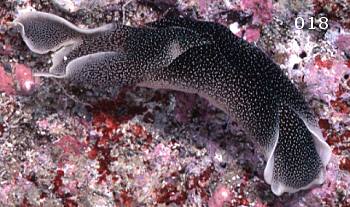
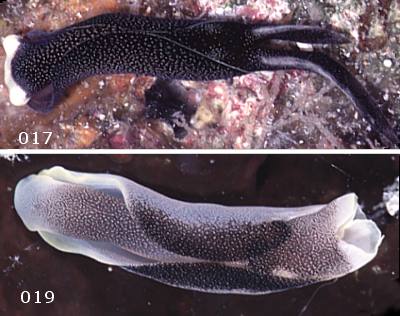
Dear Bill,
Thank you for your comment on my "yellow spotted Chelidonura." Here are some photos showing variation in Chelidonura amoena, including some with "short tails" ones. In a separate message I have sent a photo of a 'short-tailed' C. pallida.
017 - has long tails, dark form.
018 - has short tails, about 40 mm long.
019 - has very short tails, about 50 mm long.
020 - has very few white dots on body and short tails.
021 - has half long tails.
I think the attached are all C. amoena. All are from Kerama Is., Okinawa Japan.
Sincerely,
Atsushi Ono
ononini@cosmos.ne.jp
Ono. A., 2003 (Jul 2) Chelidonura amoena - shape and colour variation. [Message in] Sea Slug Forum. Australian Museum, Sydney. Available from http://www.seaslugforum.net/find/10200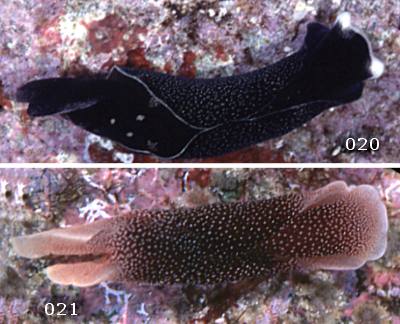
Thanks Atsushi,
You certainly have shown us that specimens of Chelidonura can lack their characteristic 'tails'. I guess its the result of either a mistake during larval development or physical damage during the life of the slug. Concerning the identity of these animals, while 18, 19, 21 seem to be C. amoena, the other two [17, 20] look rather different. They are probably the same as Lindsay Warren's photos which I kept separate as Chelidonura cf. amoena. However Nishina's photos suggests they are indeed just a form of C. amoena. We still seem to have a lot to learn about these animals
Best wishes,
Bill Rudman
Chelidonura amoena mating
June 21, 2003
From: Paul Whitehead
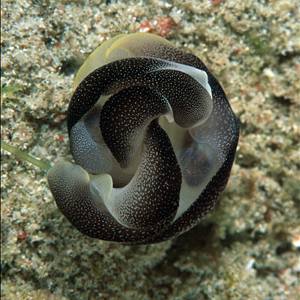
Dear Bill,
Whilst in the Puerta Gallera, Philippines in May of this year I happened across what I believe to be two Chelidonura amoena mating (?).
There where large numbers of this slug on coral outcrops at around 15 meters however this photograph was taken at about 8 meters next to a coral outcrop - I watched the two approach each other on the sand and then form this circle which I presume is their mating style (?). I had a look on your site but could not find any pictures of actions too similar for Chelidonura amoena.
Best wishes,
Paul Whitehead
whitehead@damnam.org
Thanks Paul,
Your photo is a bit like Spencer Huang's and Kelvin Tan's which show this species mating. I am interested in your suggestion of a population explosion, as this fits with Todd Garthwaite's report of large numbers in Taiwan. Perhaps it is common for this species to occur in large numbers in the northern part of its range.
Best wishes
Bill Rudman
Chelidonura amoena population explosion
May 24, 2003
From: Todd Garthwaite
Hi Bill,
There’s been another Chelidonura amoena population explosion in Dragon Cave Bay, off the NorthEast Coast of Taiwan, this spring. While this explosion comes about a month later than the one I reported back in April 2002, this population explosion is just as large if not larger. How so many Chelidonura amoena can just appear out of nowhere is truly amazing. You can’t go for more than a meter or two and not spot a cluster of Chelidonura amoena lying next to each other or entwined together. They are at all varying depths, perched on varying types of underwater terrain. One thing that this month’s Chelidonura amoena population explosion has in common with the one last year is the water temperature. Currently the temperature is 21 degrees C.; the same as last year. Maybe that’s of some significance. I wasn’t able to identify any flatworms near any of the clusters of C. amoena, though. I remember you telling me that they are the most likely source of food for this species.
While not necessarily related to the phenomenon I mentioned above, one other exciting find that I came across was one 12mm specimen of Chromodoris kuniei. I spotted it at a depth of 20 meters, along “Nudibranch Alley” in Dragon Cave Bay. I had never encountered one in Taiwan before, (although I’ve encountered dozens of them in the Philippines. Especially on the wrecks off Sabang in Puerto Galera). I watched it for about ten minutes and for a nudibranch it managed to cover quite a bit of distance rather quickly. I was most surprised. It also exhibited, as you have described it, “the characteristic mantle waving behaviour, in which all the mantle edge is raised and lowered together.” It also lifted its head up and swayed it from side to side quite a few times. It's not often you get to see nudis do that. The contrasting colors of this species of nudibranch certainly made it a joy to be seen! What a shame I didn’t have my camera handy.
Stay golden, Bill.
Peace, love, & nudis
Todd Garthwaite
typhoontoddy@yahoo.com
Garthwaite, T., 2003 (May 24) Chelidonura amoena population explosion. [Message in] Sea Slug Forum. Australian Museum, Sydney. Available from http://www.seaslugforum.net/find/10014Dear Todd,
Thanks for keeping us informed. I've got no idea why these population explosions are occurring. In Sydney, we sometimes get population explosions of one or two tropical species, which seem to be associated with eddies of warm water which drift down from the tropical north in late winter-early spring. Perhaps you have similar bodies of warm water travelling north with larvae. I suspect hese animals can grow remarkably quickly so its likely that your population explosions involve animals growing very quickly on the spot rather than migrating to an assembly point in Dragon Cave Bay. I may be wrong. I guess the only way to find out is to try and be there before they 'arrive' next year and try and find some little juveniles - not that easy I am sure. Keep an eye out for feeding events and if you can find any colour variants - perhaps even a white one - I would be very interested.
Best wishes
Bill Rudman
Re: Chelidonura amoena spawning
May 12, 2003
From: Nishina Masayoshi

Dear Bill,
Re Leanne's message. I did not know that that is the egg mass of them! Here are some photos from Japan
Hachijo Island, Japan. 30 June, 2001
Depth: 7m
Length: 40mm
Best Regards,
Nishina Masayoshi
nishina@wips.co.jp
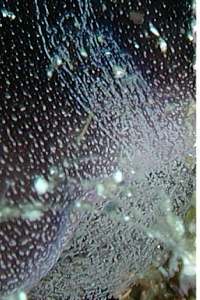
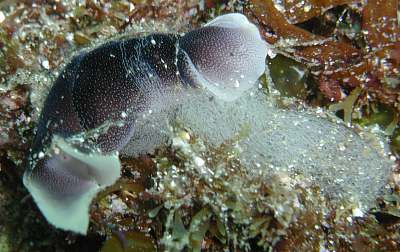
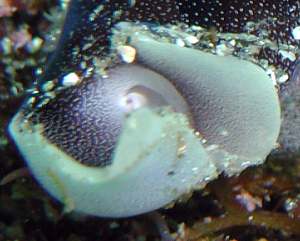
Thanks Nishina,
I am still not sure how they make the 'bubble'. You can see how they wrap the egg string around their body. I sat and watched a species of Philinopsis do the same thing one day. It was very slow. I left for 5 minutes and of course while I was gone it has somehow slipped the eggs from around its body and made the spherical, or in some cases, almost cylindrical, egg mass.
You an also see another interesting anatomical feature in one of your photos. I have posted alongside a close-up of the posterior end of the body. Chelidonura represents almost the final stage in the process by in which cephalaspidian bubble shells lost their shells and became 'complete slugs'. Unlike animals such as Atys cylindrica and Haminoea cymbalum which still have a recognisable external bubble-shaped shell, in aglajids the shell is much reduced, quite flattened, and internal. In your photo you can see the shape of the internal shell quite well. The white bit is where the flattened 'spire' of the shell sits, and the clockwise curve above this is where you will find the wide flattened body whorl.
Best wishes,
Bill Rudman
Chelidonura amoena spawning.
May 9, 2003
From: Johny Leffelaer

Dear Dr. Rudman,
This is my first addition to the Forum, which I regular visit. I thought you can use this image of a spawning Chelidonura amoena. For more images of my last trip to the Philippines, see Erwin Kohler's medslugs site,
Cheers,
Johny
johny.leffelaer@pandora.be
Leffelaer, J., 2003 (May 9) Chelidonura amoena spawning.. [Message in] Sea Slug Forum. Australian Museum, Sydney. Available from http://www.seaslugforum.net/find/9778Thanks Johny,
By chance I also have a message showing the egg ribbon of a related species, Philinopsis cyanea, which I will also post today. The transparent bubble with a spiral string of eggs is very characteristic of the aglajids. In those living in soft sandy mud, they usually attach it by a long thin mucus string, which they bury in the sand like an anchor.
Best wishes,
Bill Rudman
Chelidonura amoena from Malaysia
April 24, 2003
From: Kelvin Tan

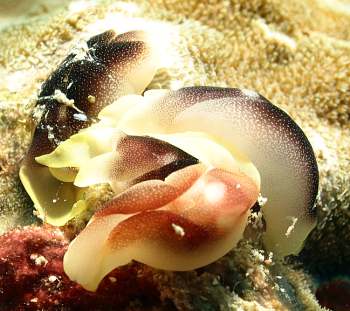
Hi,
I have found 2 separate groups of these sea slugs. One group was a set of four crowding together and the second group were just a pair. Were they mating?
Also, may I know their name?
They were found at Pulau Tioman, Malaysia.
9th March 2003. At a depth of 18m. Around 10:30am.
Kelvin Tan
lanxx@pacific.net.sg
Tan, K., 2003 (Apr 24) Chelidonura amoena from Malaysia. [Message in] Sea Slug Forum. Australian Museum, Sydney. Available from http://www.seaslugforum.net/find/9715Dear Kelvin,
This is the aglajid Chelidonura amoena. It's probable they attempt to mate whenever they find a partner. Have at look at earlier messages on this page, as I have discussed mating aggregations in this speies a number of times
Best wishes,
Bill Rudman
Cross-species matings - Chelidonura
April 10, 2003
From: Richard Willan
Dear Bill,
Since opisthobranchs are inherently rare in time and space, it follows that, theoretically, there should be more cross-species matings when individuals encounter each other than in relatively commoner molluscs. I have not seen any instances of cross-species matings in opisthobranchs myself, but believe I have documented the result of one such mating, that is a naturally-occurring hybrid individual. In the paper I published with Riccardo Cattaneo-Vietti in 1995 (on page 13), I described and illustrated one specimen of Chelidonura from Palau that seemed to be a hybrid of C. amoena with C. electra because it possesed pigmentation and shape characteristic of both species. Could you widen this page to include possible hybrids between known opisthobranch species like this one as well as records of both cross-species matings?
• Willan, R.C. & R. Cattaneo-Vietti (1995) New data on Chelidonura amoena Bergh, 1905 (Opisthobranchia: Cephalaspidea: Aglajidae). The Beagle, Records of the Museums and Art Galleries of the Northern Territory, 12: 9-18.
Regards,
Richard
richard.willan@nt.gov.au
Thanks Richard,
I'm happy to add hybrids to the page, although it is one step removed from actually seeing interactions between two species. Unless we actually see the mating and isolate the resulting eggs, saying that a particular animal is the result of a cross-species mating is a pretty risky business. It also raises the question of species definition. If two 'species' are unable to distinguish between each other, is this a comment on our ability to determine what is a species?
In the particular case of these two 'species' of Chelidonura, C. electra was named by me so I might be thought to have an interest in its future - Who would want such a spectacular animal to be lumped with dull, and much older C. amoena? Despite that, if I consistently found animals which were intermediate in colour I would be inclined to consider them to be colour variants of one species rather than hybrids of two. It is certainly something worth looking into. If anyone has further photos of these two species to add to the ones we already have, they would be very welcome.
Best wishes,
Bill Rudman
Twin Tail Nudibranch from Malaysia
October 10, 2002
From: Spencer Huang
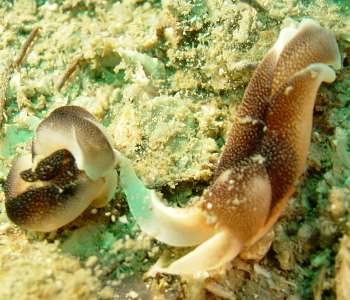
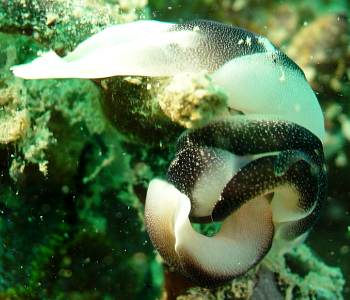
Hi Dr Rudman,
I found these species on the East Coast of Malaysia, at Pulau Perhentian. I can't found its name at my Nudibranch ID book. Would you help me ID it?
Thanks in advance....
Spencer Huang
mambo189@netscape.net
Huang, S., 2002 (Oct 10) Twin Tail Nudibranch from Malaysia. [Message in] Sea Slug Forum. Australian Museum, Sydney. Available from http://www.seaslugforum.net/find/8141Dear Spencer,
This is Chelidonura amoena. I see you have found both the 'brown' and 'black' forms together.
Best wishes,
Bill Rudman
Chelidonura amoena from Malaysia
July 19, 2002
From: Richard Houghton
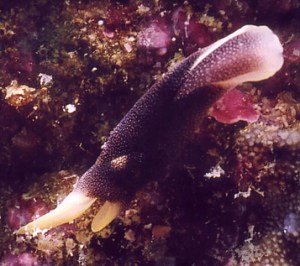
Dear Bill,
Here is another from Pulau Aur, Malaysia
It was found in 10 metres of water on it's own, though close to other species. June 2002. I did find another about 25 metres away. Once brought together, the specimens started getting to know each other better, wrapping around each other in a small ball.
Rich
richard_houghton@hotmail.com
Houghton, R., 2002 (Jul 19) Chelidonura amoena from Malaysia. [Message in] Sea Slug Forum. Australian Museum, Sydney. Available from http://www.seaslugforum.net/find/7506Thanks Rich,
This is Chelidonura amoena. It is a very streamlined 'bubble-shell' a specialisng in feeding on small flatworms which are sometimes quite common in reef environments. Like most sea slugs, these hermaphrodite animals tend to mate whenever they meet another of their own species. Considering their lack of site, their chances of meeting are quite slight, so it is probably an evolutionary necessity to be ready to mate, every time a meeting occurs.
Cheers,
Bill Rudman
Chelidonura amoena from Malaysia
July 19, 2002
From: Maliza Anuar
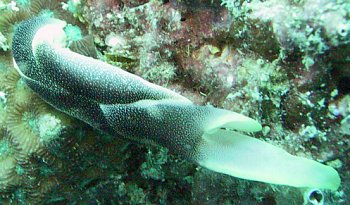
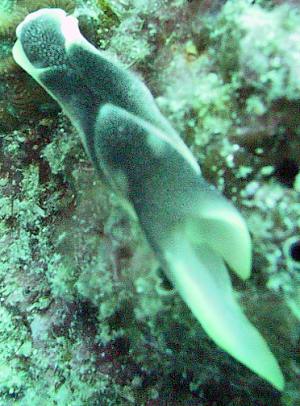
Bill,
Hare is another animal from Tioman Island, off the east coast of west Malaysia.
Dive Site: Soyak Island, 23 June 2002, 4:20pm
Depth: 12m. Size: 3-4cm
Is it a Nudi, flatworm or something else?
Maliza Anuar
emaliza@hotmail.com
Anuar, M., 2002 (Jul 19) Chelidonura amoena from Malaysia. [Message in] Sea Slug Forum. Australian Museum, Sydney. Available from http://www.seaslugforum.net/find/7513Dear Maliza,
I have just posted another photo of this species from Malaysia. Have a look at the Fact Sheet and other messages on Chelidonura amoena for more information.
Bill Rudman
Chelidonura flavolobata? from SE Sulawesi
June 16, 2002
From: Lindsay Warren
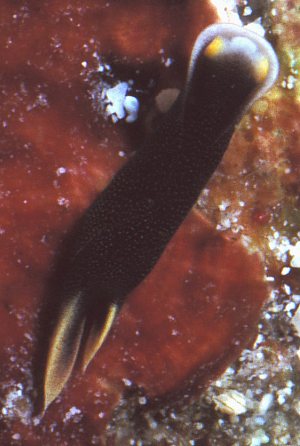
Dear Bill
I wonder if you might be able to shed some light on the identify of this little Chelidonura Unfortunately the photo was very underexposed and the specimen too small for the level of magnification available at the time.
The closest ID I could find was that of Chelidonura flavolobata (Heller & Thompson 1983) given the yellow patches on either side of its head. However, there is a broad white band along the anterior edge which does not seem to appear in the photos of C. flavolobata that you have on the Forum.
In addition to this on this specimen there faint spots along the parapodia and the tail is edged in pale yellow reminiscent of Chelidonura amoena.
It was found on 17 June 1999 by Richard Smith on Pulau Hoga, Tukang Besi Archipelago, SE Sulawesi. Approx size: 10mm. [Operation Wallacea OWN229 (OS0395)]. Photo: Lindsay Warren.
Many thanks for your help.
All the best
Lindsay
alldcl@compuserve.com
Warren, L., 2002 (Jun 16) Chelidonura flavolobata? from SE Sulawesi. [Message in] Sea Slug Forum. Australian Museum, Sydney. Available from http://www.seaslugforum.net/find/7099Dear Lindsay,
I agree that the yellow lobes do suggest C. flavolobata, but I think you are also right in thinking it may be C. amoena. Apart from colour similarities you may notice that the head in your animal is trilobed - that is there is a notch on each side of the midline at the anterior end - which is what we find in C. amoena but appears to be absent in C. flavolobata. At present, C. flavolobata is known only from the Red Sea region. My feeling is that your animal is a juvenile of C. amoena, but I can't be 100% certain because our knowledge of colour variation in these species is very poor.
Best wishes,
Bill Rudman
Re: Chelidonura amoena population explosion
June 10, 2002
From: Todd Garthwaite
Hi Bill.
I thought you might be interested to know that after diving at Dragon Cave Bay (off of Taipei County's N.E. Coast, Taiwan), last Saturday afternoon, I discovered that the population explosion of Chelidonura amoena appears to be over. As I mentioned back in April, there were hundreds upon hundreds of this particular species spread out all over the Bay. This time I came across a mere 4 specimens. There is one difference in environmental conditions, however, & that is the water temperature is now 25 degrees C.,~ back in April it was 21 degrees. However, I don't know if a temperature difference of 4 degrees is truly significant in this species vanishing.
Perhaps they just lived out their natural life spans. I wonder what the average life span is for Chelidonura amoena? Any ideas? Anyhow, it's fascinating how one species of nudibranchs can appear overnight in such large numbers, and then just as quickly disappear.
Stay golden.
Best wishes always.
Todd Garthwaite
(Taipei, Taiwan)
typhoontoddy@yahoo.com
Garthwaite, T., 2002 (Jun 10) Re: Chelidonura amoena population explosion. [Message in] Sea Slug Forum. Australian Museum, Sydney. Available from http://www.seaslugforum.net/find/7204Dear Todd,
I'm afraid we know very little about the life span of most opisthobranchs. I suspect that in this case they had reached the end of their natural lifespan but that is only a guess. I can't even say that size is any indication of age either because in New South Wales on the east coast of Australia we sometimes get great concentrations of Chelidonura in early spring, much as you are reporting. For 2-3 months there can be large numbers present, often intertidally, of C. inornata and C. fulvipunctata, they reach maturity, lay eggs and then all die. But unlike their tropical counterparts which grow to 50mm or more in length, in the temperate waters of New South Wales, they are seldom more than 15mm long.
Best wishes,
Bill Rudman
Chelidonura amoena from Christmas Island
April 30, 2002
From: W.B. Rudman
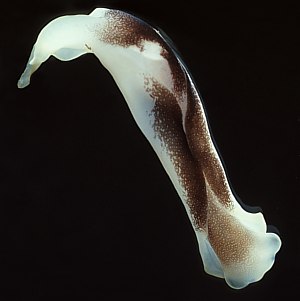
Here is some information and photos on Chelidonura amoena from John Hicks' Christmas Island, Indian Ocean collections. This animal lacks any yellow pigment.
PHOTO: AM C137600, 40 mm long alive. 28 December 1982, Christmas Is., Indian Ocean. Photo: John Hicks
Best wishes,
Bill Rudman
Chelidonura amoena population explosion in Taipei
April 27, 2002
From: Todd Garthwaite
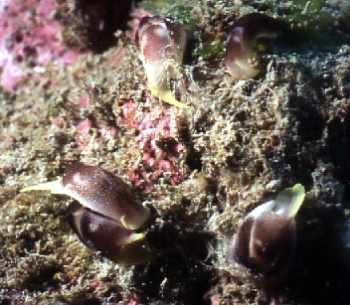
Hi Bill,
Here are some shots of different Chelidonura amoena, which I came across at a dive site called "Beyond-The-Rocks" which is located in Dragon Cave Bay, Taipei County's N.E. Coast, Taiwan.
Date: 20 April 2002
Time: between 10:34 - 11:17am
Depth: between 10 - 19.5 meters
Temp: 21 degrees C.
Two weeks before taking these pictures, I hadn't seen a single nudibranch around this site, with the exception of one small Phyllidia varicosa (which is the most common species around here). Imagine my surprise, when 2 weeks later I encounter a mind-boggling population explosion of Chelidonura amoena. There were hundreds upon hundreds of this particular species spread out all over the Bay. (Many of them were nestled or curled up next to each other. Although I'm not sure if they were mating, a great many of them seemed to be taking a very close interest in one another). To be honest, it was quite exciting, as I have never seen anything like it! First of all, C. amoena is not seen very often in Dragon Cave Bay, and secondly, in the 4 years that I've been diving at Dragon Cave Bay, I've never seen dozens, never mind hundreds and hundreds, of nudibranchs -- be it one species (as in this situation), or 20 different species combined. I am certainly confused as to why the sudden population explosion. My only speculation is that this spring, here in Taipei, we've been having a drought. There has been no rain for nearly 3 ½ months, which is extremely unusual for this time of year. Without the heavy rains that normally come around this time of year, I suspect Dragon Cave Bay has been suffering a lot less from the usual mud and silt caused by the run-off that comes downstream and into the bay from the nearby mountains. Without the usual amount of silt and run-off going into the water, perhaps something that pertains to the diet of C. amoena has had a chance to grow more abundantly, thus accounting for the enormous population explosion. Whatever the reason, it was exciting to see!
Stay golden.
Life, liberty, & the pursuit of nudis
Todd Garthwaite
(Taipei, Taiwan)
typhoontoddy@yahoo.com

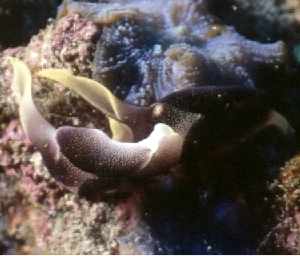
Dear Todd,
Population explosions like this are certainly exciting to see, especially when they are an animal which usually seems rare. I have over the years at times seen large populations of a number of different species of Chelidonura in different parts of the Indo-West Pacific. I guess they result from a number of particularly fortuitous events, starting with the survival in a group of a large population of veliger larvae in the plankton, which are able to settle together and successfully survive together to adulthood. This would, among other things, require a good supply of food. We think that all species of Chelidonura feed on small flatworms, so if you are back at the same place it might be worth having a look for a plague of flatworms. Have a look at Haruo Kinoshita's message about an acoel flatworm for a photo of the most likely food of Chelidonura.
Best wishes,
Bill Rudman
Chelidonura amoena from Taiwan
April 1, 2002
From: Todd Garthwaite
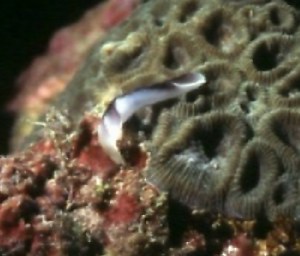
Hi Bill,
As requested, here's a nudibranch photo from Taiwan. I'm guessing this a Chelidonura amoena. Since Taiwan is located between between Okinawa and the Philippines, I was surprised to hear you say that very little is known about the fauna of this area. If it can be of any help to you and the Forum, I'd be delighted to contribute what little I have in the way of photos of nudibranchs from Taiwan. I hope this photo can get you started. More to come in the following week, or so, (and a lot more to come once the dive season kicks off next month).
Here are some further details:
Date/ Time: 07/14/'01, 08:58am
Dive site: "Beyond-The-Rocks",
Location: Dragon Cave Bay, N.E. Coast, Taiwan
Depth: 17.9 meters
Water temperature: 27 degrees C.
Size: Approx. 35mm.+
Stay golden.
Best wishes,
'Life, liberty, & the pursuit of nudis.'
Todd Garthwaite
(Taipei, Taiwan)
typhoontoddy@yahoo.com
Garthwaite, T., 2002 (Apr 1) Chelidonura amoena from Taiwan. [Message in] Sea Slug Forum. Australian Museum, Sydney. Available from http://www.seaslugforum.net/find/6551Thanks Todd,
Yes this is C. amoena. I look forward to your contributions. There are a few publications on the Taiwanese fauna but like most parts of the Indo-West Pacific there have been few faunal studies undertaken so we have much to learn about what is there.
Best wishes,
Bill Rudman
Chelidonura amoena - colour variation
February 21, 2002
From: Nishina Masayoshi
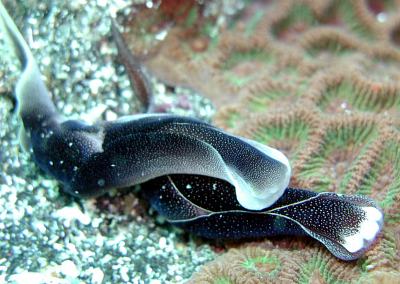

Dear Bill,
I have been looking at an old message where you have identified this species as Chelidonura cf. amoena. I think it is a color form of C. amoena. C. amoena is common in Hachijo Is, Japan. Attached are some interesting photos of C. amoena mating. April to early July is their mating season in Hachijo Is. Water temp is around
18C degree to 20C in the period.
Data:
Date:1 5 April, 2001
Location: Hachijo Island Japan
Depth: 6m
Length: 40mm to 50mm
Best Regards,
Nishina Masayoshi
http://umiushi.zive.net/index.html
nishina@wips.co.jp
Masayoshi, N., 2002 (Feb 21) Chelidonura amoena - colour variation. [Message in] Sea Slug Forum. Australian Museum, Sydney. Available from http://www.seaslugforum.net/find/6161Dear Nishina,
Your animals are not actually mating but they are indeed 'interested' in each other. In the aglajids, the penis is on the right anterior corner of the head while the female genital opening is way back in the small reduced mantle cavity at the posterior end of the body. When thet mate, aglajids usually get together head to 'tail' with the one acting as the male being behind the one acting as a female. Like Sea Hares they can form mating chains of 3 or more animals.
I agree with your suggestion that Lindsay Warren's specimens are a colour form of C. amoena.
Best wishes,
Bill Rudman
Chelidonura amoena from the Philippines
June 16, 2001
From: Mary Jane Adams

Hi Bill,
This is another slug I found on my recent trip to the Philippines. Chelidonura amoena appears to be fairly common here, however it was new to me. Batangas, Philippines, Divesite: Devil's Point, Depth: about 8 meters, Length: 22mm, May 5, 2001
Best regards,
Mary Jane
divepng@yahoo.com
Adams, M.J., 2001 (Jun 16) Chelidonura amoena from the Philippines. [Message in] Sea Slug Forum. Australian Museum, Sydney. Available from http://www.seaslugforum.net/find/4575Thanks Mary Jane,
Bill Rudman
Chelidonura cf. amoena from SE Sulawesi
March 1, 2000
From: Lindsay Warren
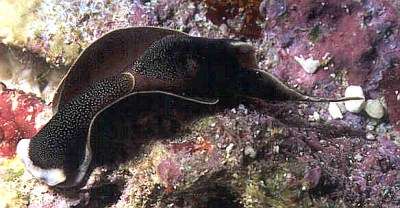

Dear Bill
We were puzzled by this Chelidonura which was found by Lucy O'Connor on 27
October 1999 at a depth of 10 m moving slowly down some encrusting coral on a wall of Pulau Hoga [Tukang Besi Archipelago, SE Sulawesi, Indonesia - Operation Wallacea]. Size: 21 mm.
The body is dark brown / black and has numerous fine light coloured spots over the central body and tails as well as the parapodia. The tails are edged in a diffuse cream band. The white band on the front of the head lacks the orange and blue markings normally seen on C. inornata. Photos: Lindsay Warren.
Is this just a variant or a separate species?
All the best
Lindsay Warren
100014.2112@compuserve.com
Lindsay Warren, 2000 (Mar 1) Chelidonura cf. amoena from SE Sulawesi. [Message in] Sea Slug Forum. Australian Museum, Sydney. Available from http://www.seaslugforum.net/find/1991Dear Lindsay,
It certainly looks less colourful than normal C. inornata and unlike that species this animal has white spots on the head shield and posterior shield as well as the parapodia. It also looks quite like Chelidonura amoena but the white band across the anterior end of the head is more definitively outlined in this animal than in C. amoena and in that species there is usual traces of yellow on the border. So I can suggest what it is not but I'm not too sure if it is a new species.
Cheers,
Bill Rudman.
Chelidonura amoena from the Philippines
May 1, 1999
From: Erwin Koehler
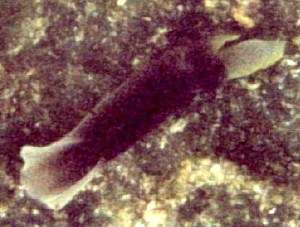
Dear Bill,
Here is one more photo of my latest trip to the Philippines. Please excuse the poor quality - the camera didn't work allright. Philippines, Cebu Is., divesite Oslob sanctuary, March 1999, 6m depth, size 14 mm. This one looks similar to Chelidonura amoena in Debelius' book, but I don't know, which others might look the same...
Thanks
Erwin
Medslugs.Koehler@t-online
Koehler, E., 1999 (May 1) Chelidonura amoena from the Philippines. [Message in] Sea Slug Forum. Australian Museum, Sydney. Available from http://www.seaslugforum.net/find/817Dear Erwin,
Yes its C. amoena. In its palest colour form the background is white with grey patches on the head and posterior shields and on the parapodia.
I sympathise with your camera problems. On my last trip to New Caledonia, my first 6-7 rolls of film turned out black because of flash and battery problems. Luckily some sixth sense told me that something was wrong and I was able to find and fix the problem. But for the next 3 weeks and 30+ rolls of film, I had this nagging doubt that perhaps I hadn't fixed it. Luckily when I returned to Australia and had the films processed, only the first rolls were a disaster. Even that was sad because as always happens there were a number of interesting animals in those first rolls which we never found again.
Best wishes,
Bill Rudman.
